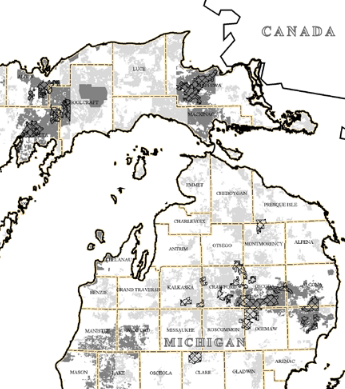Birdfinding.info ⇒ Access to the principal nesting areas of this famously rare species is restricted and it is scarce elsewhere, so the only reliable way find a Kirtland’s Warbler is to go on an organized tour. The Huron-Manistee National Forest in Mio, Michigan, conducts daily tours in the second half of May, and the Michigan Audubon Society in Grayling conducts daily tours from late May to the end of June. Elsewhere, migrants have been found about annually at Magee Marsh (Ohio) and Point Pelee National Park (Ontario), usually May 5 to 15. It is hard to find on its Bahamian wintering grounds but, reportedly, local guides know of consistent sites in Abaco National Park.
Kirtland’s Warbler
Setophaga kirtlandii
Breeds in the Jack Pine belt of the Great Lakes region. Winters in the Bahamas. Rare but increasing from population lows of approximately 150 pairs in 1974 and 1987. Due to intensive conservation efforts, by 2012 the species had rebounded to more than 2,000 pairs.
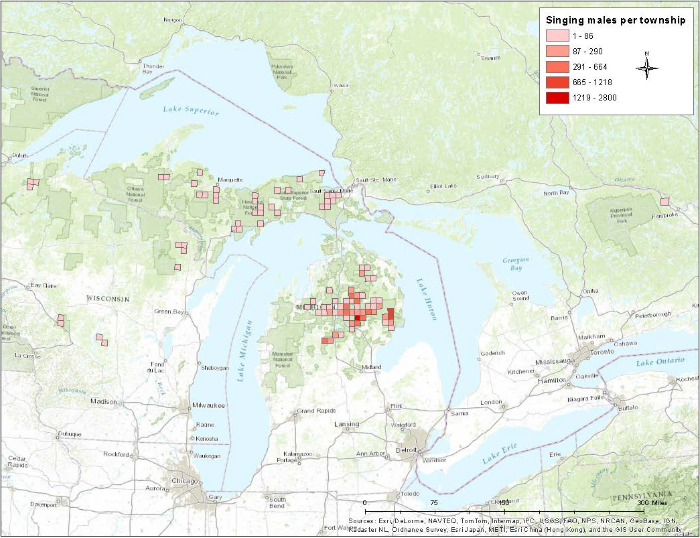
Numbers of singing males in known or presumed breeding areas. Kirtland’s Warbler Breeding Range Conservation Plan 2015
Breeding. Has a highly specialized preference for extensive stands of young Jack Pine—about 5 to 15 feet tall—where it breeds in locally high densities. This habitat occurs naturally about 5 to 15 years after a wildfire, but under existing fire suppression regimes it occurs only through deliberate forest management practices of clear-cutting and replanting. (See Kirtland’s Warbler Recovery and Long-Term Survival Prospects in Notes, below.)
The bulk of the population (>95%) breeds in the Au Sable River drainage and nearby areas in the northern portion of Lower Michigan. Much smaller, but increasing, numbers breed in Michigan’s Upper Peninsula and at scattered locations in Wisconsin. There is also an isolated breeding area in eastern Ontario (Petawawa) and evidence of additional breeding in remote areas of southwestern Quebec.
Nonbreeding. Winters in dense brush, mainly on Eleuthera, Cat Island, and San Salvador, but also regular on Abaco and probably Andros, Exuma, and other nearby islands. There are historical records, but apparently no recent ones, south to Turks & Caicos.
As its population has recovered, individual Kirtland’s Warblers have been documented wintering west of the Bahamas: in southern Florida, on Cayo Coco (north-central Cuba), and Jamaica. Its winter range may be expanding along with its breeding range and overall population.
Movements. Most migrants follow a fairly direct route between the breeding grounds and the Bahamas. Records of individuals encountered en route in spring have been predominantly in Ohio, southwestern Ontario, southeastern Michigan, and few recently in the Chicago area. Most fall records have come from western North Carolina and along coast from South Carolina to southern Florida.
Northbound migration occurs in May, with departures around the beginning of the month and most arrivals in the middle. Spring records away from the breeding grounds typically occur around May 5 to 15. Southbound migration is more prolonged, with some birds departing the breeding grounds in August, but some remaining until early October.
Identification
One of the largest wood warblers, with a robust body, large head, heavy bill, and long tail, which it habitually wags. Except when singing, it tends to remain low in vegetation.
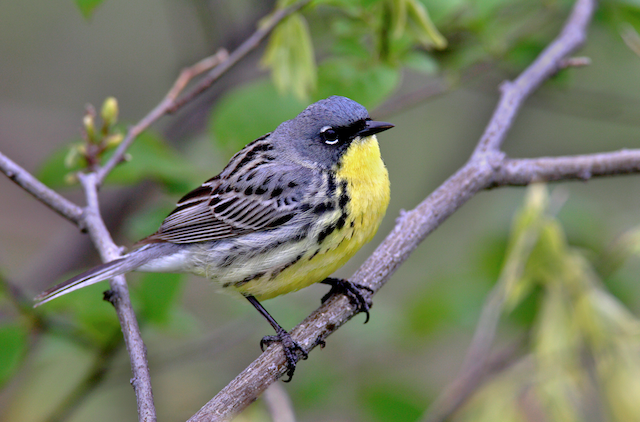
Kirtland’s Warbler, male in breeding plumage. (Point Pelee National Park, Ontario; May 15, 2008.) Anonymous eBirder
Adult male has mostly gray upperparts and yellow underparts, and bold black streaks on the back, wings, and sides, with a black mask and white crescents above and below the eyes.
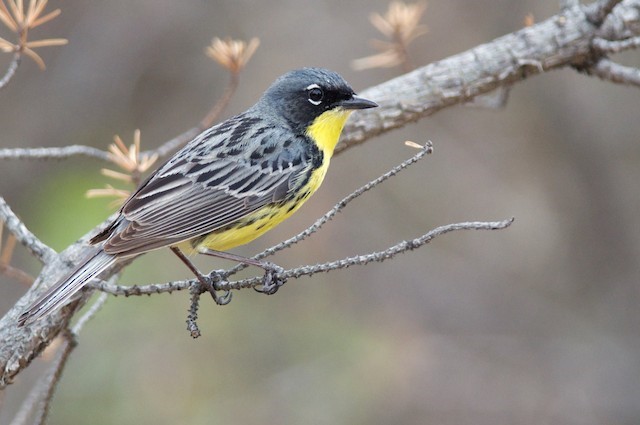
Kirtland’s Warbler, male in breeding plumage. (Grayling, Michigan; May 24, 2015.) © Amanda Guercio
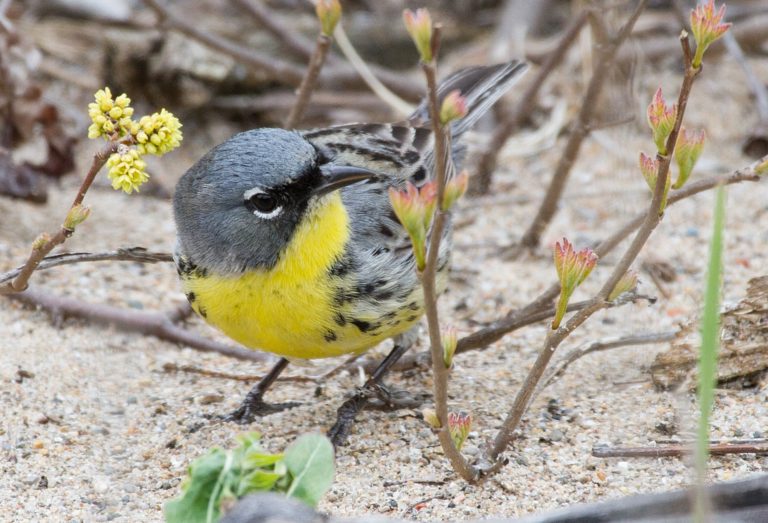
Kirtland’s Warbler, male in breeding plumage. (Point Pelee National Park, Ontario; May 9, 2016.) © Robin Edwards
Breeding plumage is more vivid than nonbreeding—after the summer molt, the colors appear washed out.

Kirtland’s Warbler, male in breeding plumage. (Stonington Jack Pine Plains, Hiawatha National Forest, Michigan; June 22, 2018.) © Joe McDonnell
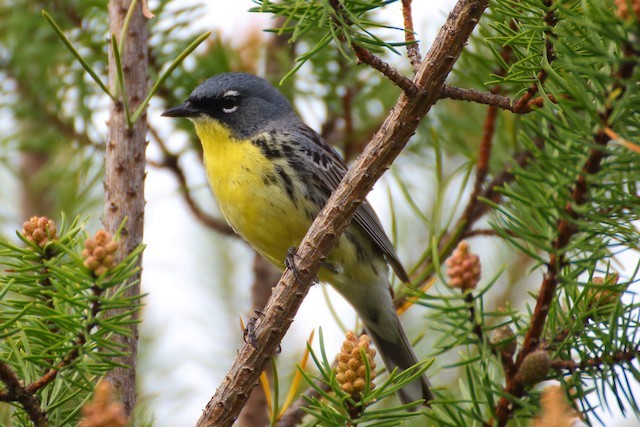
Kirtland’s Warbler, male in breeding plumage. (Helmer Lake Road, Lewiston, Michigan; May 16, 2017.) © Ray Bontrager

Kirtland’s Warbler, male in breeding plumage. © Joel Trick
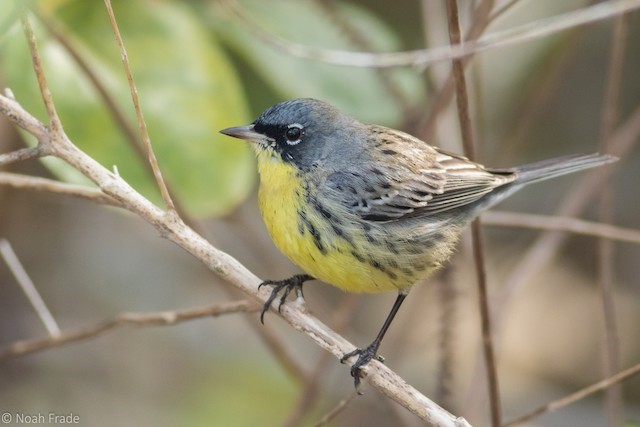
Kirtland’s Warbler, male entering breeding plumage. (Bill Baggs Cape Florida State Park, Florida; February 15, 2017.) © Noah Frade
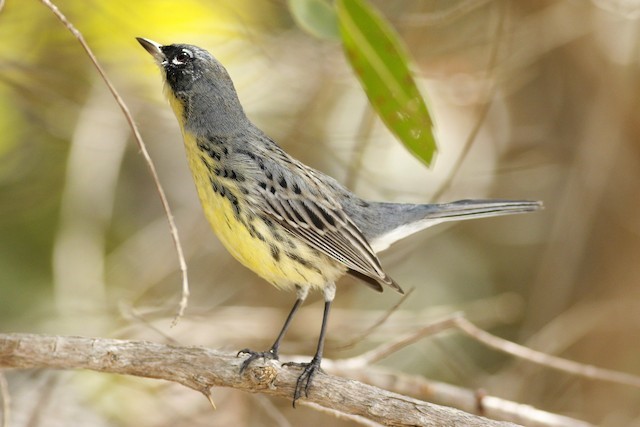
Kirtland’s Warbler, male entering breeding plumage. (Bill Baggs Cape Florida State Park, Florida; February 15, 2017.) © Miriam Avello
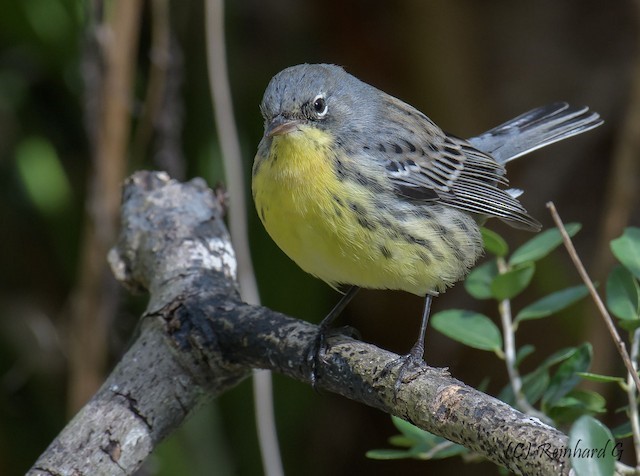
Kirtland’s Warbler, male in nonbreeding plumage. (Washington Oaks Gardens State Park, Palm Coast, Florida; October 21, 2018.) © Reinhard Geisler
First-spring males closely resemble adult males, but with fine black streaks or speckles on the breast and pale gray or brownish tones on the upperparts, and often showing a weaker version of the adult’s black mask.

Kirtland’s Warbler, first-year male in breeding plumage—note fine speckling on the chest. (Stubbs Park, Centerville, Ohio; May 5, 2016.) © Jacob Roalef
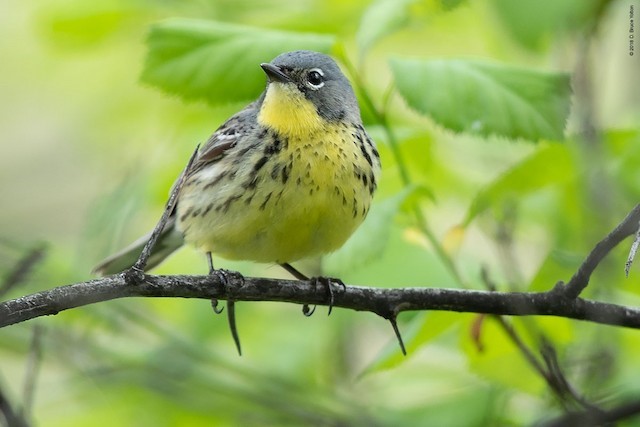
Kirtland’s Warbler, first-year male in breeding plumage. (Central Park, New York, New York; May 12, 2018.) © D. Bruce Yolton
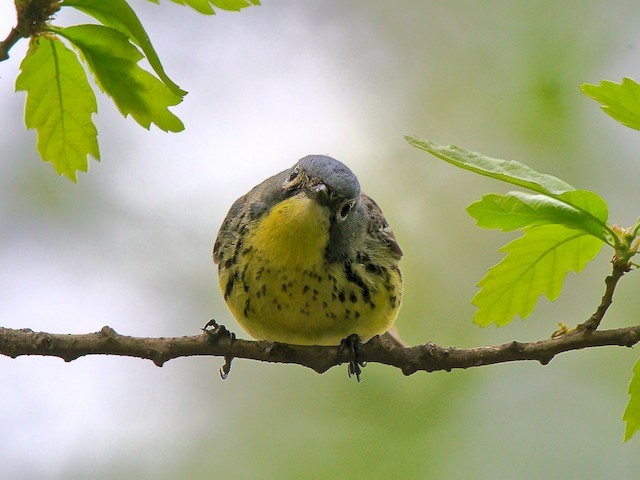
Kirtland’s Warbler, first-year male in breeding plumage. (Central Park, New York, New York; May 12, 2018.) © Matthieu Benoit
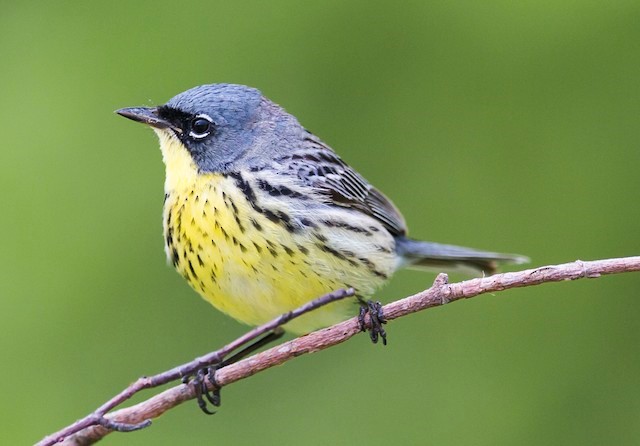
Kirtland’s Warbler, first-year male in breeding plumage. (Lincoln Park, Chicago, Illinois; May 16, 2015.) © B.J. Worth

Kirtland’s Warbler, first-year male in breeding plumage—note brown tones on the back and wings. (Central Park, New York, New York; May 12, 2018.) © Matthieu Benoit

Kirtland’s Warbler, first-year male in breeding plumage. (Central Park, New York, New York; May 11, 2018.) © Ethan Goodman
Females are similar to males but browner on the upperparts—typically pale brownish-gray with dark brown (not black) streaks—and paler yellow on the underparts. In fall, the female’s upperparts are even browner. Most diagnostically, the female lacks the male’s black mask.
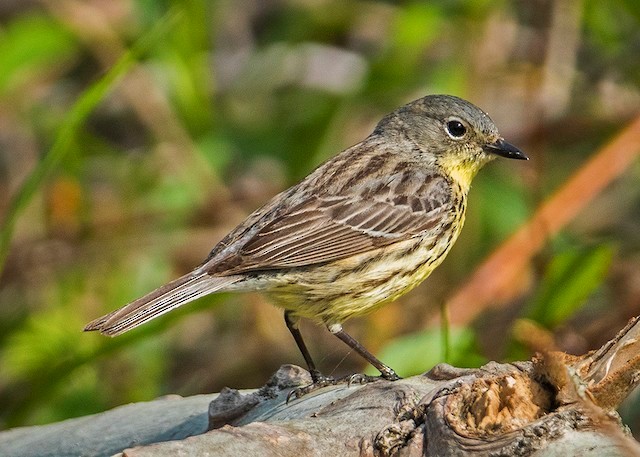
Kirtland’s Warbler, female in spring plumage. (Big Creek National Wildlife Area, Long Point, Ontario; May 16, 2018.) © Ron Ridout
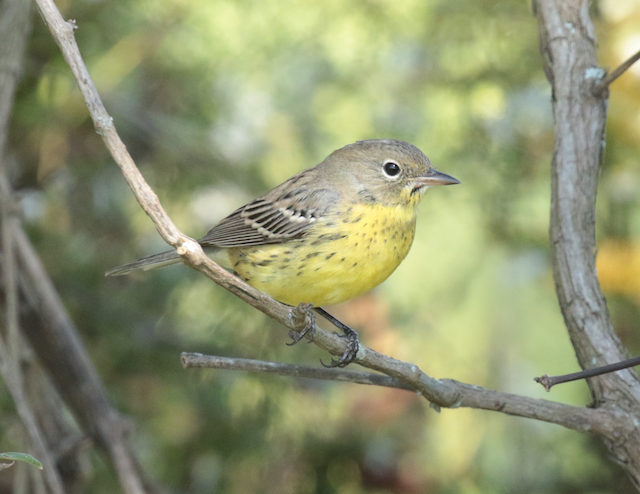
Kirtland’s Warbler, female in fall plumage. (Battelle Darby Creek Metro Park, Galloway, Ohio; September 30, 2018.) © Paul Jacyk
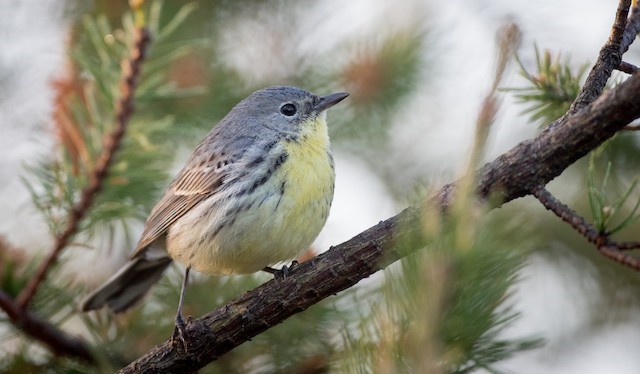
Kirtland’s Warbler, female in spring plumage. (Mason Tract, Roscommon, Michigan; May 27, 2017.) © Ian Davies
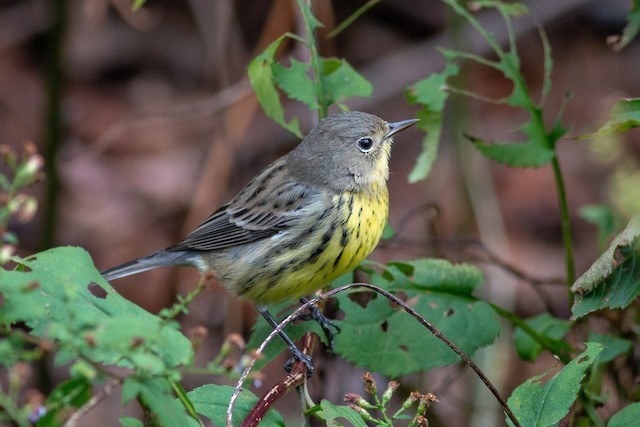
Kirtland’s Warbler, female in fall plumage. (Black Mountain, North Carolina; October 2, 2018.) © Jeff O’Connell
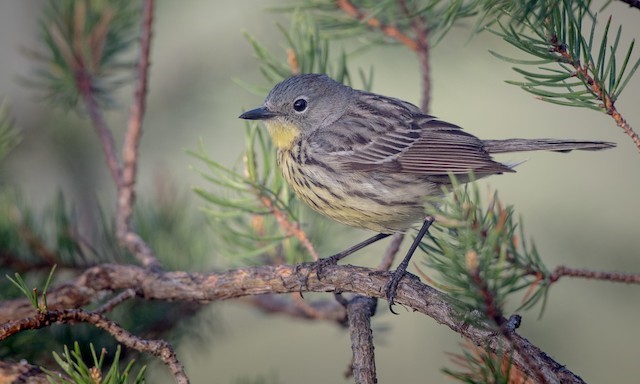
Kirtland’s Warbler, female in spring plumage. (Mason Tract, Roscommon, Michigan; May 27, 2017.) © Ian Davies
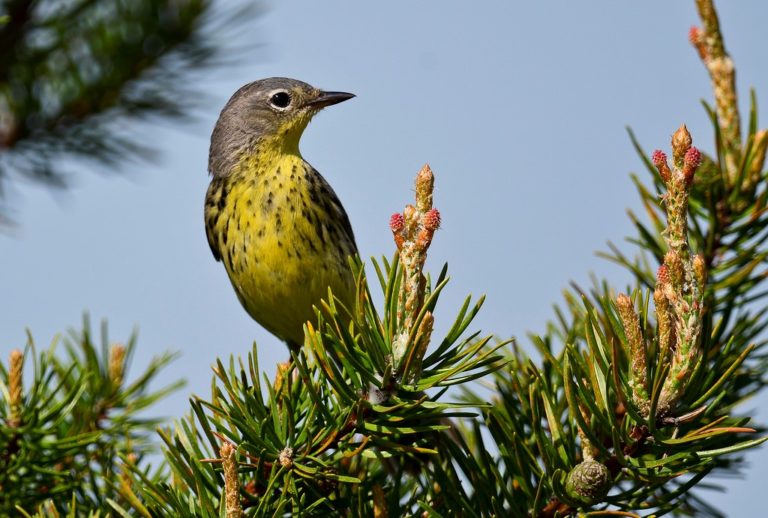
Kirtland’s Warbler, female in spring plumage—extensive speckling likely indicates first-spring. (Mio, Michigan; May 27, 2018.) © David Cree
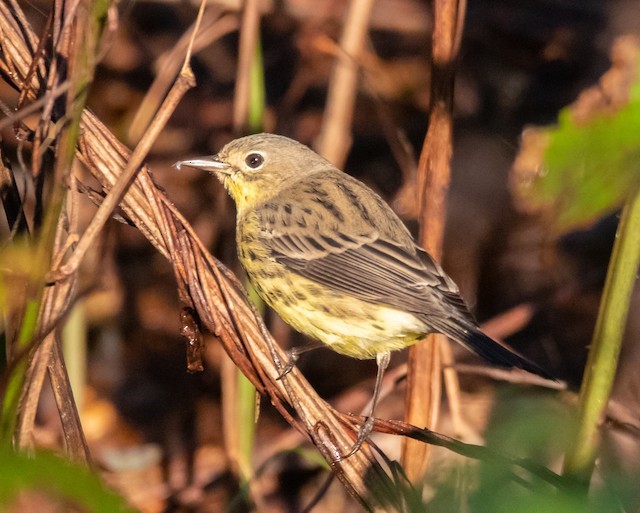
Kirtland’s Warbler, female in fall plumage. (Black Mountain, North Carolina; October 1, 2018.) © Peter Quadarella
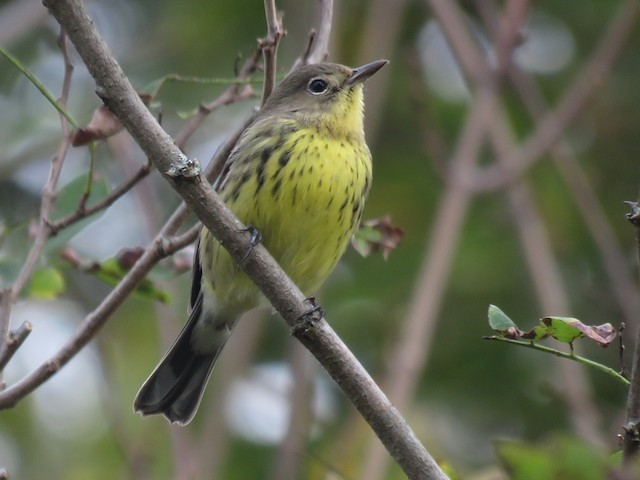
Kirtland’s Warbler, female in fall plumage. (Black Mountain, North Carolina; September 26, 2018.) © Kent Fiala
Cf. Magnolia Warbler. Nonbreeding male Magnolia Warblers superficially resemble female Kirtland’s Warblers, but there are clear differences. Magnolia Warblers are smaller and more arboreal than Kirtland’s, they do not habitually wag their tails, and they always have yellow on the rump.
Notes
Monotypic species.
IUCN Red List Status: Near Threatened.
Kirtland’s Warbler Recovery and Long-Term Survival Prospects.
Kirtland’s Warbler was among the first species listed under the Endangered Species Act, which enabled a timely mobilization of resources to study and save it. Without the heroic interventions that followed, it would almost certainly have gone extinct. The main problem is that its breeding habitat is ephemeral and exists in nature only as a result of the wildfires that occur about once per fifty years in unmanaged Jack Pine forest. A second existential threat is brood parasitism by the Brown-headed Cowbird, which followed human settlement into the warbler’s range in the mid-1900s and caused fledging rates to plummet until biologists established a trapping program.
Recovery efforts in the 1960s and ’70s concentrated on controlled burning to maintain an inventory of regrowing Jack Pine forest of varying ages to ensure that there would always be sufficient acreage of suitable habitat. In 1980, however, one such controlled burn grew beyond control and became the infamous Mack Lake Fire, causing one death (of the biologist who was attempting to manage the fire) and significant losses of private property.
Ironically, the Mack Lake Fire was a one-time windfall for the warbler, as it created far more habitat than intended and was likely instrumental in launching the skyrocketing population increase that began around 1990 (see bar graph “Kirtland’s Warbler Rangewide Breeding Census Results”). But the catastrophe also removed controlled burning from the conservation toolkit.
Subsequent creation of breeding habitat has been effectively limited to harvesting (by clear-cutting) mature Jack Pine stands and replanting them. This is a controversial and labor-intensive method of habitat restoration, but some techniques have been introduced to increase the longevity of the habitat created: in particular, variations in topography and stand density, which improve the overall quality of the habitat and create niches that become usable at different stages of maturity. (The areas under some form of management regime for Kirtland’s Warbler breeding habitat are indicated by cross-hatching on the antique-looking map.)
Ultimately, there is a concern that the Kirtland’s Warbler will become a victim of its own success. Its populations have more than doubled the number established as its recovery goal, and it is likely to be removed from the Endangered Species List. At that point, it will no longer command the full complement of resources needed to maintain sufficient breeding habitat. If, in addition, climate change or insect infestations suddenly degrade its existing habitat, its unusually strict requirements may render it vulnerable to sharp declines.
References
Alderfer, J., and J.L. Dunn. 2014. National Geographic Complete Birds of North America (Second Edition). National Geographic Society, Washington, D.C.
BirdLife International 2018. Setophaga kirtlandii. The IUCN Red List of Threatened Species 2018: e.T22721722A132146817. http://dx.doi.org/10.2305/IUCN.UK.2018-2.RLTS.T22721722A132146817.en. (Accessed April 4, 2019.)
Dunn, J.L., and K.L. Garrett. 1997. A Field Guide to Warblers of North America. Houghton Mifflin, Boston.
eBird. 2019. eBird: An online database of bird distribution and abundance. Cornell Lab of Ornithology, Ithaca, N.Y. http://www.ebird.org. (Accessed April 3, 2019.)
Michigan Department of Natural Resources, U.S. Fish & Wildlife Service, and U.S. Forest Service. 2015. Kirtland’s Warbler Breeding Range Conservation Plan. https://www.michigan.gov/documents/dnr/Kirtlands_Warbler_CP_457727_7.pdf.
Raffaele, H., J. Wiley, O. Garrido, A. Keith, and J. Raffaele. 1998. A Guide to the Birds of the West Indies. Princeton University Press, Princeton, N.J.
Rapai, W. 2012. The Kirtland’s Warbler. The University of Michigan Press, Ann Arbor.
Rolling Harbour. 2018. Kirtland’s Warblers: Abaco’s Rare Treasures. https://rollingharbour.com/2018/04/16/kirtlands-warblers-abacos-rare-treasures/.


